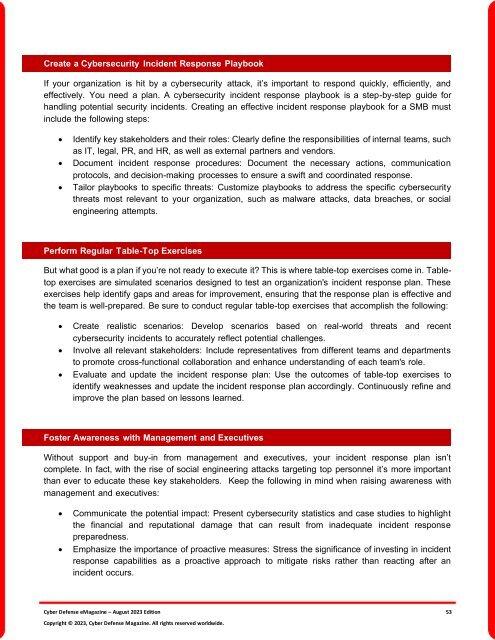The Cyber Defense eMagazine August Edition for 2023
Cyber Defense eMagazine August Edition for 2023 #CDM #CYBERDEFENSEMAG @CyberDefenseMag by @Miliefsky a world-renowned cyber security expert and the Publisher of Cyber Defense Magazine as part of the Cyber Defense Media Group as well as Yan Ross, Editor-in-Chief and many more writers, partners and supporters who make this an awesome publication! Thank you all and to our readers! OSINT ROCKS! #CDM #CDMG #OSINT #CYBERSECURITY #INFOSEC #BEST #PRACTICES #TIPS #TECHNIQUES
Cyber Defense eMagazine August Edition for 2023 #CDM #CYBERDEFENSEMAG @CyberDefenseMag by @Miliefsky a world-renowned cyber security expert and the Publisher of Cyber Defense Magazine as part of the Cyber Defense Media Group as well as Yan Ross, Editor-in-Chief and many more writers, partners and supporters who make this an awesome publication! Thank you all and to our readers! OSINT ROCKS! #CDM #CDMG #OSINT #CYBERSECURITY #INFOSEC #BEST #PRACTICES #TIPS #TECHNIQUES
You also want an ePaper? Increase the reach of your titles
YUMPU automatically turns print PDFs into web optimized ePapers that Google loves.
Create a <strong>Cyber</strong>security Incident Response Playbook<br />
If your organization is hit by a cybersecurity attack, it’s important to respond quickly, efficiently, and<br />
effectively. You need a plan. A cybersecurity incident response playbook is a step-by-step guide <strong>for</strong><br />
handling potential security incidents. Creating an effective incident response playbook <strong>for</strong> a SMB must<br />
include the following steps:<br />
• Identify key stakeholders and their roles: Clearly define the responsibilities of internal teams, such<br />
as IT, legal, PR, and HR, as well as external partners and vendors.<br />
• Document incident response procedures: Document the necessary actions, communication<br />
protocols, and decision-making processes to ensure a swift and coordinated response.<br />
• Tailor playbooks to specific threats: Customize playbooks to address the specific cybersecurity<br />
threats most relevant to your organization, such as malware attacks, data breaches, or social<br />
engineering attempts.<br />
Per<strong>for</strong>m Regular Table-Top Exercises<br />
But what good is a plan if you’re not ready to execute it? This is where table-top exercises come in. Tabletop<br />
exercises are simulated scenarios designed to test an organization's incident response plan. <strong>The</strong>se<br />
exercises help identify gaps and areas <strong>for</strong> improvement, ensuring that the response plan is effective and<br />
the team is well-prepared. Be sure to conduct regular table-top exercises that accomplish the following:<br />
• Create realistic scenarios: Develop scenarios based on real-world threats and recent<br />
cybersecurity incidents to accurately reflect potential challenges.<br />
• Involve all relevant stakeholders: Include representatives from different teams and departments<br />
to promote cross-functional collaboration and enhance understanding of each team's role.<br />
• Evaluate and update the incident response plan: Use the outcomes of table-top exercises to<br />
identify weaknesses and update the incident response plan accordingly. Continuously refine and<br />
improve the plan based on lessons learned.<br />
Foster Awareness with Management and Executives<br />
Without support and buy-in from management and executives, your incident response plan isn’t<br />
complete. In fact, with the rise of social engineering attacks targeting top personnel it’s more important<br />
than ever to educate these key stakeholders. Keep the following in mind when raising awareness with<br />
management and executives:<br />
• Communicate the potential impact: Present cybersecurity statistics and case studies to highlight<br />
the financial and reputational damage that can result from inadequate incident response<br />
preparedness.<br />
• Emphasize the importance of proactive measures: Stress the significance of investing in incident<br />
response capabilities as a proactive approach to mitigate risks rather than reacting after an<br />
incident occurs.<br />
<strong>Cyber</strong> <strong>Defense</strong> <strong>eMagazine</strong> – <strong>August</strong> <strong>2023</strong> <strong>Edition</strong> 53<br />
Copyright © <strong>2023</strong>, <strong>Cyber</strong> <strong>Defense</strong> Magazine. All rights reserved worldwide.

















